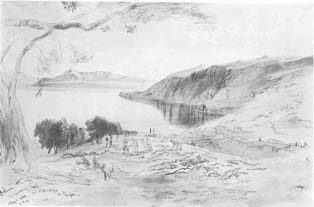
Bulletin 25, 1975
Home
Français
Introduction
History
Annual Index
Author &
Subject
Credits
Contact

Lyttleton's
View of Halifax: Microscopic Cosmos
by Alexandra E. Carter
Pages 1
| 2
| 3 | 4
| 5
In 1856, Lear went to Corfu with the intention of producing another
book which was never realized, but for which he made over three
hundred sketches, "by my usual dilatory but sure process of
penning out and colour, thanks to after dinner application and
stayathomeaciousness." (27) These Corfu works, especially, bring
Lyttleton to mind (but earlier works do so as well) because of the
wide vista, the tension created by interest focused simultaneously
on foreground detail and the distant horizon, the delicacy yet
sureness of the contour outline seen in the silhouetted hills, and
finally the impression of detail achieved with only the slightest
indication of line or stroke. A drawing from the Corfu period titled
Ithaca (28)
(fig. 10) shows the landscape anchored by a large
tree in the left contracting in a wedge-shape pattern to the right,
curving, sweeping back to the left, and together with a distant land
mass, enveloping a large body of water. The impression of vastness is analogous to the
effect of Lyttleton's Panoramic view of Halifax. Lear included a group of men
working in the field in the middle-ground: with a few brief strokes
he subordinates these within the larger framework yet he describes
each particular and individual gesture, as well as suggesting the
characteristic details of costume such as headdress and trouser
belts. Lyttleton achieves a comparable effect with the deftly - yet
convincingly - rendered sheep in the centre foreground. An early
steam vessel entering Halifax Harbour appears to be no more than a
single horizontal stroke, yet conveys such specific information as
the prow configuration, the semicircular form which encloses the
paddle wheel, and the smokestack between the two masts. (29) A
square-rigged vessel at the left of the picture is another example
of microscopic accuracy.
The variety of line and brushstroke which the two men display
adds interest and expression. (Lyttleton relied almost exclusively
on watercolour, while Lear frequently favoured the pen.) The
vertical lines forming the slender tree trunks are evidence of
Lyttleton's firm control and sense of authority. Leaves arc formed
by deft strokes of a fairly dry brush, and the shadows are imparted
by quick sweeps of a heavily-charged brush over the surface.
What one is to make of the analogy between Lyttleton and Lear is
hard to know.
Conclusion
Captain Lyttleton's View of Halifax from McNab's Island
follows
the tradition of the British topographical watercolour, but within
the confines of the format becomes an exceptional artistic statement
in its own right. This is in part owed to the unusual and unique
compositional qualities, the panoramic breadth of the vision, and
the variety of stylistic detail. It is, perhaps, significant that
Lyttleton was not a transient, as were so many artists who
"viewed the Canadian scene through British spectacles." (28)
He developed a feeling for it and identified with it. Lyttleton
becomes far more than an artist in this instance; he is a man of
property, of the very McNab's Island in the fore-ground, and he
chooses to view the city in the distance across the water much as
a symbol of the civilized and superior uniqueness of his own
existence. In that sense he was set apart from Short, Petley, and
Bartlett. Lyttleton's interpretation of the Halifax environment is
enhanced by those intrinsic qualities resulting from attachment
with, and belonging to, a specific locality. Such attributes arc
not to be found in works by other artists treating the same subject.
Next Page | Notes
1
| 2
| 3 | 4
| 5
Annual Index | Author & Subject | Credits | Contact
This digital collection
was produced under contract to Canada's Digital Collections program,
Industry Canada.
"Digital
Collections Program, Copyright
© National Gallery of
Canada 2001"